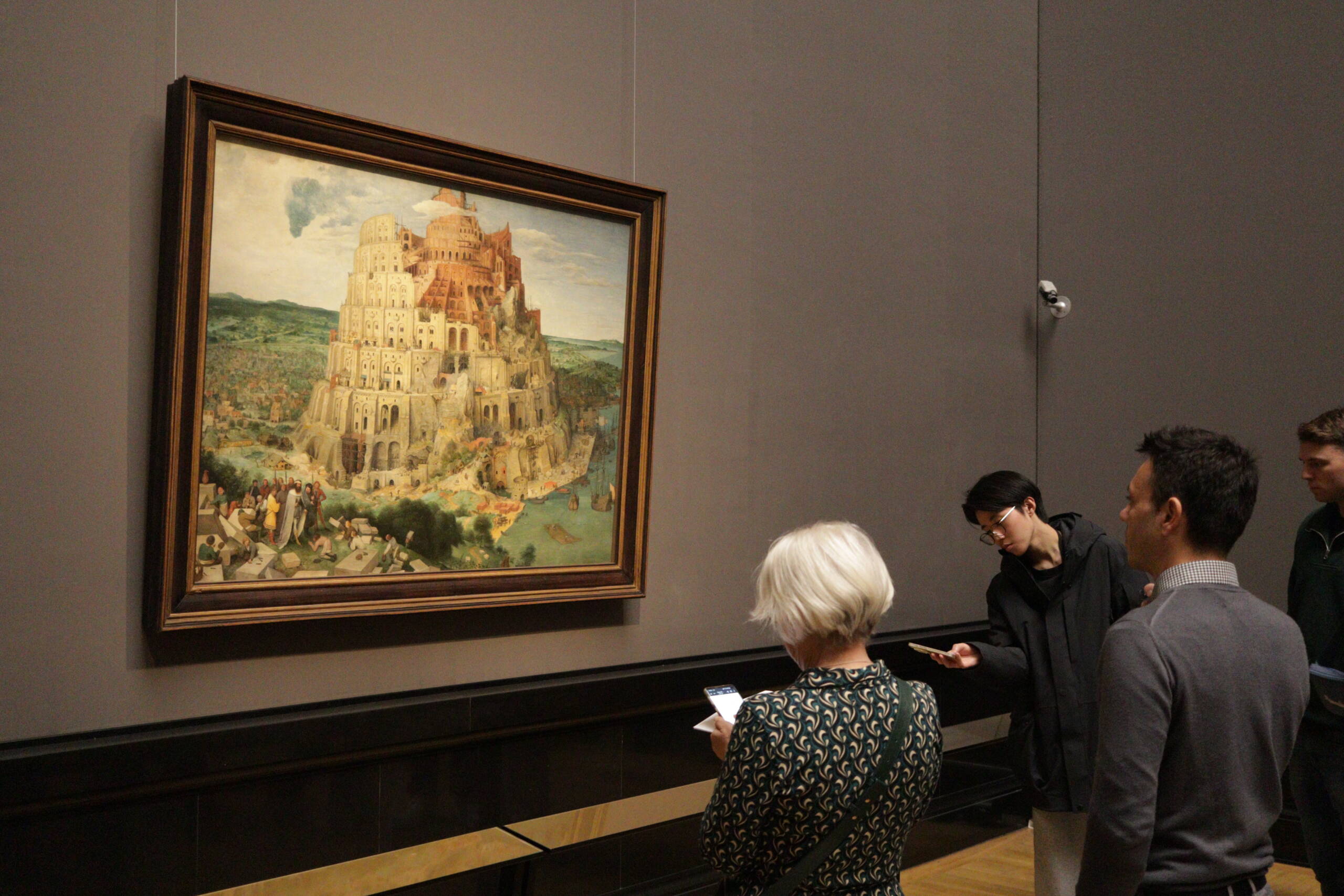There are museum moments that feel like encounters with history, and then there are museum moments that feel like encounters with ourselves. Standing in front of Pieter Bruegel the Elder’s Tower of Babel in Vienna’s Kunsthistorisches Museum is firmly the latter. The painting is more than oil on oak; it is a mirror, a metaphor, and a warning. It depicts the biblical tower said to have been built on the plains of Shinar, a project born of humanity’s collective ambition to reach the heavens. Bruegel translates that myth into a striking visual narrative, layering his tower with such realism that one can almost hear the clamor of construction, the strain of human hands dragging stone, and the chatter of different tongues filling the air.

But this is no simple moral illustration. In the 16th century, Bruegel was painting against a background of political upheaval. The Netherlands were under Habsburg rule, and the tower, with its imperial grandeur and authoritarian order, was seen by many scholars as a critique of overreaching monarchies. Some argue that the tower, deliberately modeled after the Roman Colosseum, was Bruegel’s way of pointing to the arrogance and decadence of empire. By likening Babel to Rome, he quietly suggested that all empires share the same flaw: the ambition to reach higher than their foundations will allow. So, the painting functions on multiple registers—it is at once biblical allegory, political commentary, and architectural fantasy.
In the museum today, however, it takes on yet another dimension. Observing the visitors clustered around the painting is almost as fascinating as the painting itself. Four people stand before it in the photograph, each embodying a different relationship to art in the digital age. One bends closer, straining to match brushstrokes with detail, her phone in hand like a secondary lens. Another seems absorbed, tilting his head slightly, as though looking for an entry point into the painting’s dense symbolism. A woman with white hair gazes not at the canvas but at her smartphone, perhaps scanning for information or posting a photo. The irony is almost too perfect: the original story of Babel was about fractured language and the scattering of meaning, and here too the act of looking is fragmented—split between screen and surface, attention and distraction, silence and chatter.
Art history often reminds us that Bruegel was a master of embedding human folly within everyday detail. The tiny figures in the painting, dwarfed by the colossal spiral above them, mirror the museum visitors dwarfed by the work today. Both are part of the same cycle: humanity striving toward scale, and individuals trying to situate themselves within it. What is most haunting is that Bruegel’s tower is not painted as a triumph but as a ruin-in-progress. Even as it climbs toward the sky, cracks appear in the lower levels, scaffolds dangle precariously, and the weight of ambition presses visibly against the limits of stone. The tower is doomed from the very moment it rises.
This allegory of collapse resonates powerfully in our time. We live in what some have called a new Babel age—not of bricks and mortar but of networks and data. Our skyscrapers stretch impossibly high, our digital infrastructures expand with limitless ambition, our AI systems promise to solve every problem, and yet, like Bruegel’s tower, they carry within them the seeds of their undoing. Fragmentation is no longer a divine punishment but a structural feature of modern life. Languages divide us less than platforms do, attention spans fracture under the weight of notifications, and human unity remains as elusive now as it was in the myth. The very presence of smartphones in the hands of visitors reinforces this continuity: we try to climb toward knowledge, toward connection, but our tools both elevate and fragment the experience.
And yet, this fragmentation is not entirely destructive. It creates unexpected forms of unity. Visitors from across the world gather around Bruegel’s work, speaking different languages, engaging with different cultural frames, yet standing shoulder to shoulder before a single canvas. The multiplicity of perspectives is no longer only a curse but a form of enrichment. If Babel was once a story of loss—of unity broken apart—it might also now be read as a story of resilience, of difference embraced rather than mourned. Bruegel’s tower still dominates the room, but the crowd around it forms a living testament to the paradox of human ambition: we fail to reach heaven, but we succeed in gathering under one roof.
The Kunsthistorisches Museum provides the perfect stage for this tension. Its architecture is itself a kind of imperial tower, a 19th-century monument to Habsburg wealth and ambition. To encounter Bruegel’s satirical tower within these halls is to double the irony: a painting critiquing imperial overreach housed within an imperial palace. The neutral gray wall and careful lighting only heighten the contrast, pulling viewers into the vivid hues of the tower and its surrounding landscape. The Danube plain stretches behind the structure in soft greens and blues, suggesting both the fertility of the earth and the smallness of the tower against nature’s expanse. Humanity builds, but the earth endures.
Walking away from the painting, the experience lingers not just as an aesthetic memory but as a philosophical one. The story of Babel is not only about divine punishment but about human persistence—the refusal to accept limits, even when collapse is inevitable. Bruegel knew this, which is why his painting continues to speak across centuries. It speaks in Vienna today just as it did in Antwerp in 1563, and it will continue to speak as long as humans keep building towers—whether of stone, steel, or silicon. What the museum visitor experiences is not only the weight of art history but the recognition that we are still, all of us, inhabitants of Babel, forever striving, forever scattering, and forever circling back to wonder at the ruins we create.
Leave a Reply